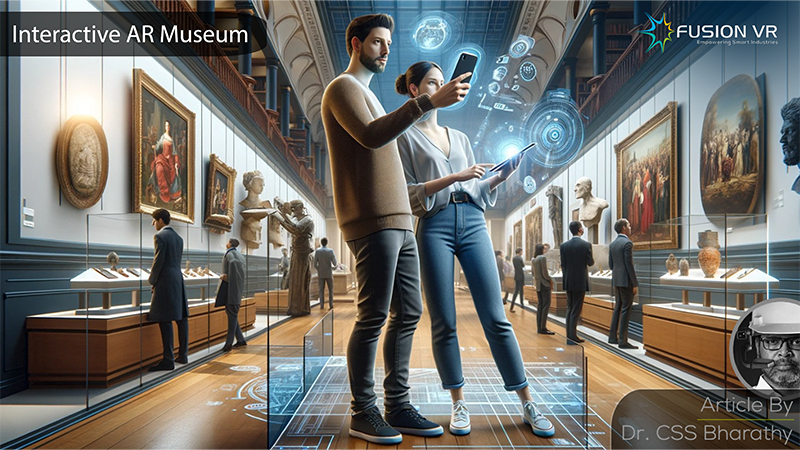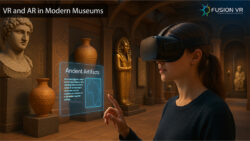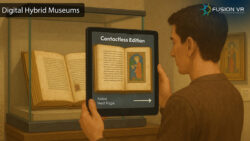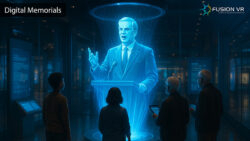The digital age has in its wake made us lose or ignore many of the pleasures of the past. Visiting museums was one such event that many kids and even adults looked forward to a few decades ago. A school trip usually meant a museum visit to see and feel awestruck at the artistic, archaeological and architectural wonders of the world. Sadly, today the aura of museums is slowly waning and easily available forms of entertainment have gained much attention. The smartphone has brought entertainment as well as learning literally to your fingertips. It is ironic that we may obtain help from the same digital technologies to enable the revival of the lost aura of museums.
Augmented reality is a real cool technology that helps overlay digital content on the reality surrounding us. We view this reality using devices such as smartphones, tablets and specially designed goggles. Augmented reality provides information and content that enables us to obtain a rich and interactive experience of the real world around us. This kind of interactive experience allows us to better understand and appreciate everything we see. Augmented reality applications aren’t very new if you have one of those who has played Pokemon Go on your smartphone. Several other useful applications have been developed to help people with their day-to-day needs. More applications that will make a difference in people’s lives are being developed every day. The field of museums is no exception and many AR solutions have been deployed to make a visitor’s experience in a museum more interactive, engaging and memorable.
Here are seven ideas for using augmented reality in museums that will enhance museum visitors’ experience. Please consider these ideas and incorporate them in your discussions with museum stakeholders on future augmented reality museum projects.
Idea number one! Present information to museum visitors with their own smartphones.
Most traditional museums have several artifacts and paintings that have little or no information about it. Any visitor strolling past an artifact may be lucky to see a name against it. A museum guide could provide more information about the main artifacts, but a museum has thousands of exhibits and it may not be possible for anyone to remember and share details about them. Museums can work with augmented reality solution providers to develop applications that deliver interactive content about each artifact by just scanning a QR code next to it. The content can be simple text or an audio description of the artifact. It could also generate a video about the artifact. Museum experts can decide on the most effective way to deliver the details a visitor would be interested in.
Idea number two! Use augmented reality to show greater detail of any artifact using 3D models.
The only way to view a sculpture for example would be its front view. In most cases, it’s enclosed in a glass case and doesn’t enable a viewer to see the remaining sides. That deprives any visitor of a wholesome view of the artifact and unlocks interesting aspects of it. AR comes to the rescue, by providing a highly realistic 3D model of the artifact on your smartphone, allowing the viewer to rotate and flip it, thereby viewing it from all angles. It may also provide the ability to zoom in to view it in finer detail or have an exploded or even an x-ray view to see its internal structure and construction.
Idea number three! Enjoy the museum with your custom-built tour guide.
Anyone visiting famous museums would find museum guides willing to take you around and share their knowledge of the objects it has. In some cases, the tour may not be interesting or to your liking. Augmented reality can help you design a tour based on what you are most interested in and deliver information as a virtual personal guide. The application would guide you through the museum with voice and visual content through your smartphone. This enables you to not only focus on the areas you wish to see but also make the most of your valuable time that day. The application would have pre-designed tours from which you can choose from or create your own.
Idea number four! Engage youngsters with games.
One of the most popular things to do in a museum would be a treasure hunt. The goal would be to locate a series of artifacts that are situated in different sections of the museum with clues provided that lead to the final treasure. This activity would need to be completed within a certain time by individuals or as a team. The augmented reality application enables the visitor to navigate and also locate clues that eventually help them to find the treasure. This is one example and there could be many more games that can be created to make the overall experience in a museum interesting and memorable.
Idea number five! Make museums places of learning.
Teaching history or science in the classroom would be easy for many teachers, but they may not always achieve the desired depth of understanding and level of knowledge retention. A learning exercise at the museum to help students learn goes a long way. The students see, touch and feel artifacts which leave an indelible impression in their minds. Augmented reality-powered learning applications can be designed to incorporate specific learning objectives which children can achieve as part of a museum tour.
Idea number six! Create your own personalized memorabilia for posterity.
Augmented reality can be used to include your picture holding an artifact or standing beside another even though they are enclosed and not accessible. These could be like selfies with famous leaders, dead and alive that could be created with augmented reality. These photographs could be shared through social media for the pleasure of those in the visitor’s community. A quick visit to the Amma Museum in Chennai would provide an excellent example of this use case.
Idea number seven! Let the world around you come alive!
Using solutions developed and a quality smartphone, the world around you comes alive with digital objects, artifacts and even creatures. The smartphone pans around and you see these things appear and interact with you. An augmented reality exhibit in Singapore, shows the flora and fauna in a rainforest come alive, showing visitors the magical creatures that typically live there. Such experiences immerse the visitors in a magical atmosphere and deliver an unforgettable encounter within the augmented reality experience centre.
These are seven of the many interesting use cases for augmented reality that deliver an interactive museum experience. Creating such experiences requires a good understanding of what museums want and collaborating with key stakeholders within the museum organization from the start to finish of an AR project. Solution providers need to have the technical, artistic, construction and most importantly project management expertise to design, develop and execute such projects. There is a need for such solution providers to have cross-functional expertise within the organisation to develop such experiences. Fusion VR is undoubtedly a leader in delivering such experiences. A visit to our Museums and Corporate Experience Centres webpage will reveal the extent of our expertise and our contributions to this industry. The webpage also features useful information that will further your understanding of AR and other cool technologies that improve the quality of visitor experiences in museums. Our goal has always been to see increased use of AR in museums and elevate the quality of the augmented reality museum experience.





